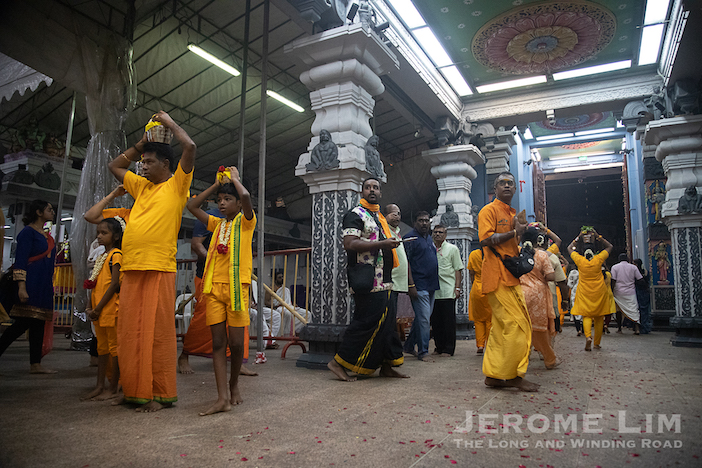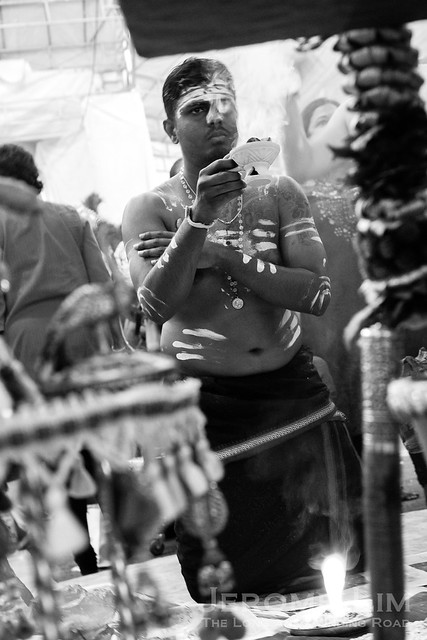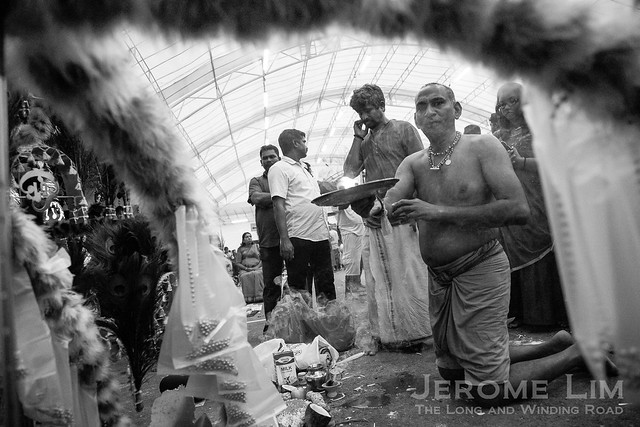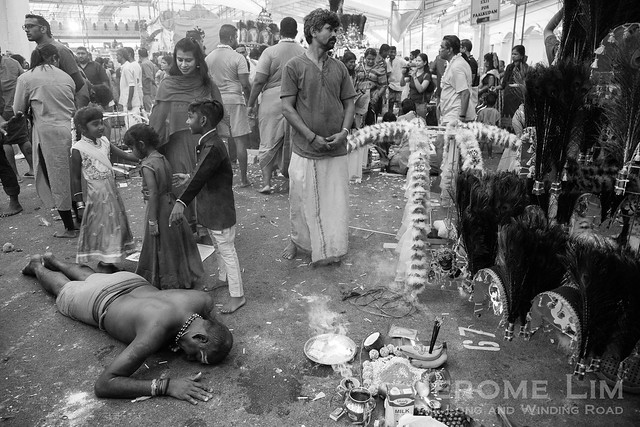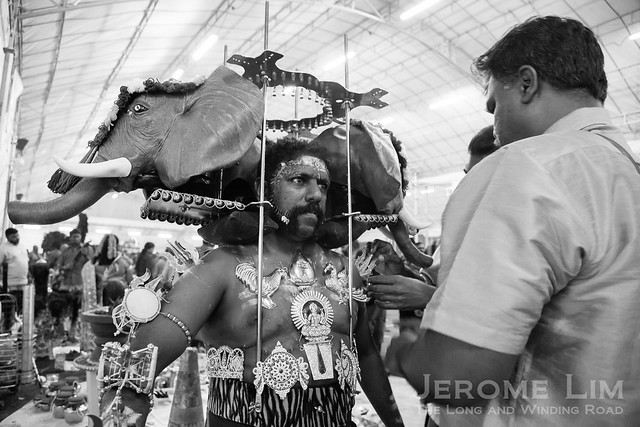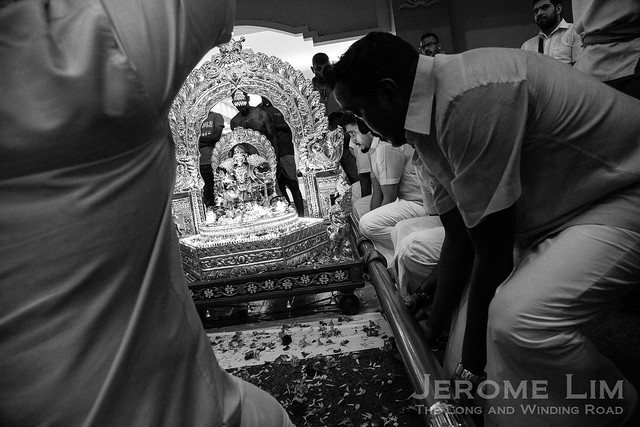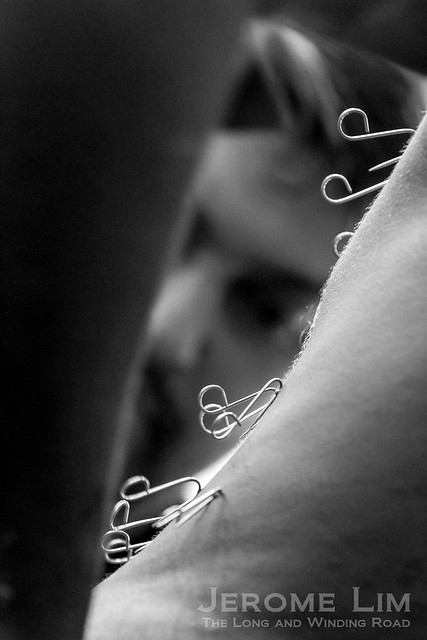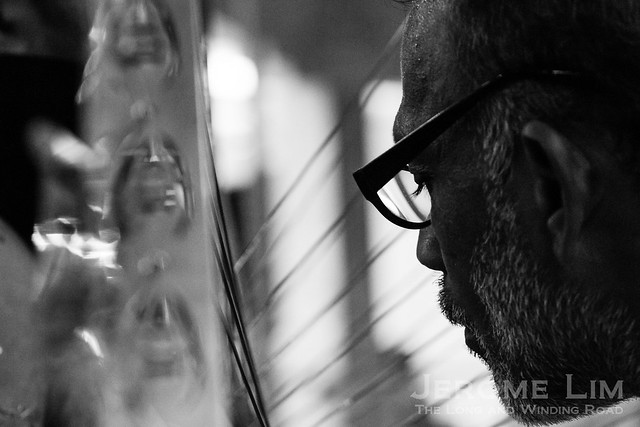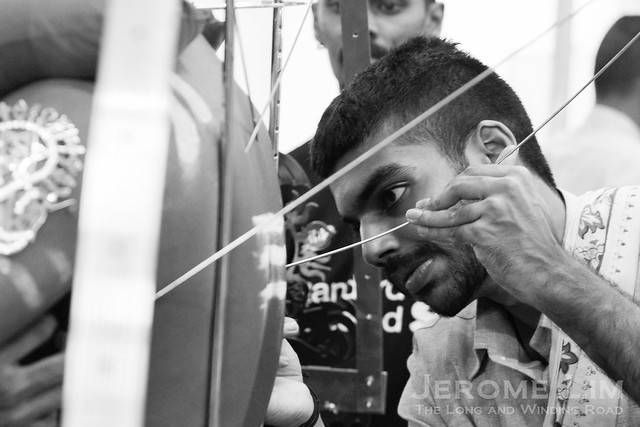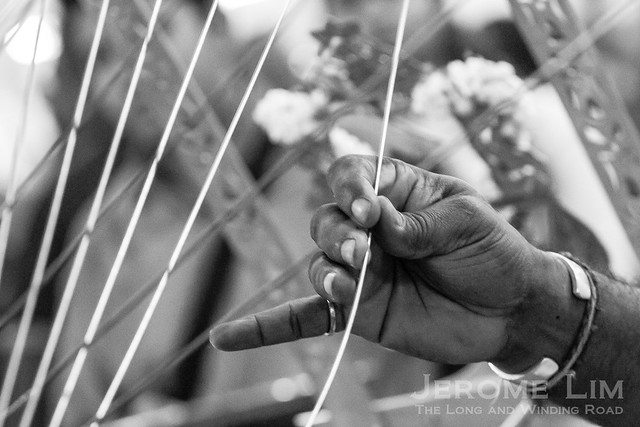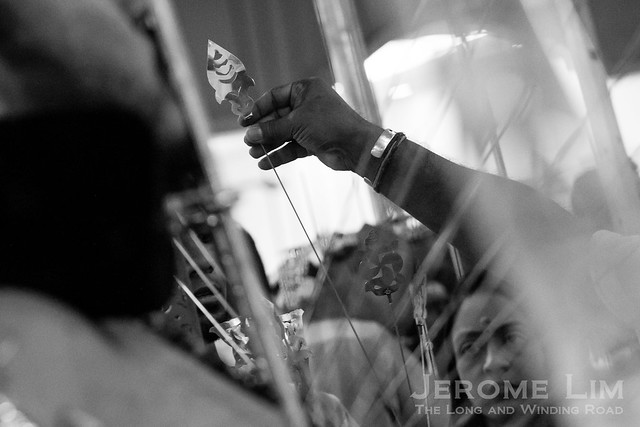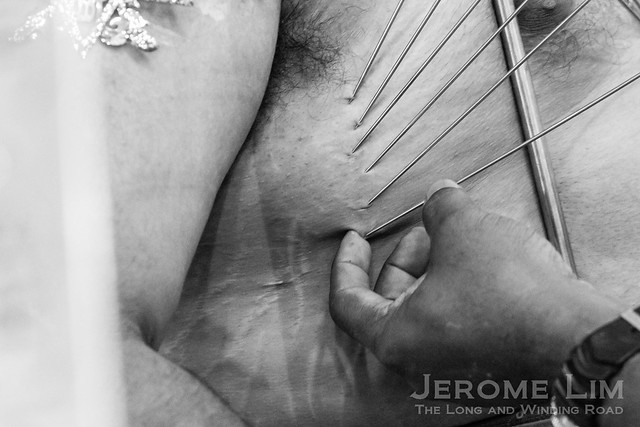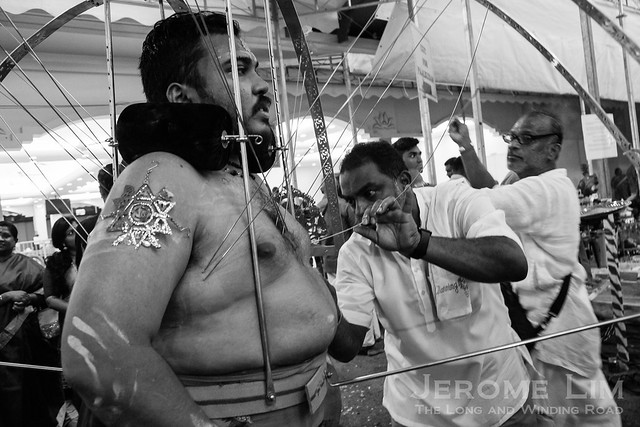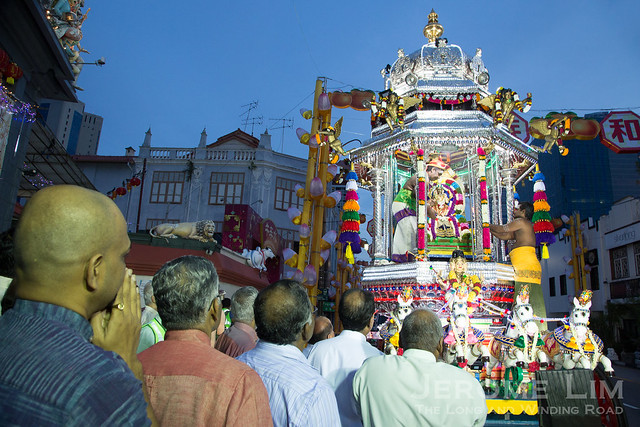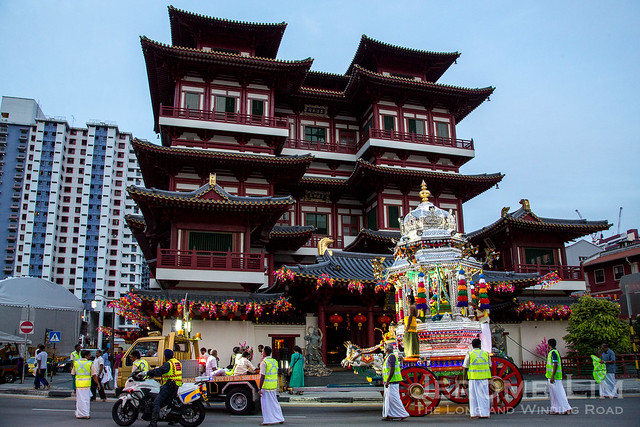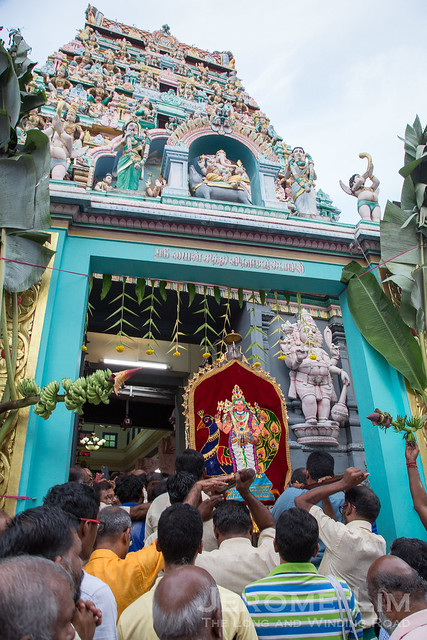Yesterday, the day of the full moon of the Tamil month of Thai, saw the most lively and colourful of festivals, Thaipusam, being celebrated by the Hindu community. A very visible part of the festival is a procession of devotees carrying kavadis. In Singapore, the kavadis, some weighing as much as 40 kilogrammes, are carried along a route from the Sri Srinivasa Perumal Temple in Serangoon Road to the Chettairs’ or Sri Thendayuthapani Temple at Tank Road.
The annual procession remains as one of the most colourful religious and cultural celebrations in Singapore even without the chanting, singing, music and dancing, which would have flavoured it in its pre-1973 days. This year, a total ban on music was lifted, and this saw musical instruments allowed at designated points along the procession route. The festival is one of two occasions during which kavadis are carried, the other being the Panguni Uthiram festival celebrated during the full moon of the month of Panguni.
Photographs from Thaipusam 2016























More information on the festival from the Hindu Endowments Board’s website:
Thaipusam which falls in the Tamil month of Thai (usually January/ February) is an annual foot procession by Hindu devotees seeking blessings, fulfilling vows and offering thanks. Thaipusam is celebrated in honour of Lord Subrahmanya (also known as Lord Murugan) who represents virtue, youth and power to Hindus and is the destroyer of evil.
On the day before Thaipusam, a statue of Lord Subrahmanya decorated with jewels and finery and together with his two consorts, Valli and Devayani, is placed on a chariot and brought in procession. In Singapore, the chariot procession begins from the Sri Thendayuthapani Temple to Layan Sithi Vinayagar Temple at Keong Siak Road. The procession symbolizes the blessings sought by Lord Subrahmanya from his elder brother Lord Vinayagar.
Thaipusam ceremony starts in the early hours of the morning when the first batch of devotees of Lord Subrahmanya carrying milk pots and wooden kavadis leave Sri Srinvasa Perumal Temple for Sri Thendayuthapani Temple at Tank Road. The milk in the pots they carry are offered to the deity of Lord Subrahmanya at Sri Thendayuthapani Temple. Some devotees pierce their tongues with skewers and carry a garlanded wooden arch across their shoulders. Others devotees may carry a kavadi (semi circular metal structure decorated with peacock feathers, flowers and plam leaves). The spiked kavadis which require elaborate preparations leave the temple in the later part of the morning and continue till 6pm.
Carrying kavadi is a popular form of devotion for Hindus. It is usually carried in fulfillment of a vow that a devotee would have taken. Placing a kavadi at the end of the foot procession at the altar of Lord Subrahmanya and making an offering of milk symbolizes the cleansing of the mind and soul and seeking of blessings.
In preparation for carrying a kavadi, a devotee has to prepare himself spiritually. For a period of about a month, the devotee must live a life of abstinence whilst maintaining a strict vegetarian diet. It is believed that only when the mind is free of material wants and the body free from physical pleasures that a devotee can undertake the sacred task without feeling any pain.
More information on the kavadi, its origins and some of the various forms it takes from the Thaipusam.sg site:
There are many types of offerings, which the devotee makes to his beloved deity Sri Murugan. A special offering is the carrying of kavadi and there is a Puranic legend behind this practice.
There was once a great saint called Agasthya who rested at Mount Pothikai. Agasthya dispatched one of his students, Idumban, to Mount Kailai Range instructing him to bring back two hills called Sivagiri and Shakthigiri belonging to Lord Murugan.
As instructed, Idumban having arrived at Mount Kailai, picked up both the hills, tied them and swung them across his shoulders.
Lord Murugan had other plans. He wanted the two hills to be placed at Thiruvavinankudi (Palani) and at the same time test the devotion and tenacity of purpose of Idumban.
Idumban who was on his way back with the hills suddenly found himself lost. Lord Murugan appeared as a king, riding a horse led Idumban to Thiruvavinankudi (Palani) and requested Idumban to rest there so that he could continue his journey later.
Having rested, Idumban tried to carry the two hills but strangely found that he could not do so. A perplexed Idumban looked up and saw a child in loincloth standing atop one of the hills. Idumban requested the child to get down, however, the child refused claiming that the hills belonged to him. An angered Idumban attempted to attack the child but found himself falling like an uprooted tree. A scuffle ensued and Idumban was defeated. Only then did Idumban realize that the child was none other than Muruga or Subrahmanya Himself – the ruling deity of the region. Idumban craved the pardon of the divine child and also sought the boon that anyone who comes to the hills to worship Sri Muruga with an object similar to the two hillocks suspended by a load bearing pole, may be granted his heart’s desire. Idumban’s wish was granted. Murugan also said that he would bless those who bring sandal, milk, flowers, etc. in a kavadi to His shrine. Hence, the practice of carrying a kavadi.
At the Sri Thendayuthapani Temple, one can see a small sanctum dedicated to Idumban. Devotees who usually fast for Thaipusam break their fast one day later after offering their prayers to Idumban.
The simplest kavadi consists of a short wooden pole surmounted by a wooden arch. Pictures or statues of Lord Murugan or other deities are fixed onto the arch. The kavadi is decorated with peacock feathers and a small pot of milk is attached to each end of the pole.
There are more elaborate kavadis that devotees carry. The alagu and ratha kavadi are common forms of kavadi carried by devotees during Thaipusam. Kavadis are affixed on a bearer’s body by long sharpened rods or by chains and small hooks. A kavadi bearer not only carries a gift for God but the whole kavadi is seen as a shrine for God Himself.
Devotees who intend to carry kavadis are customarily required to observe strict physical and mental discipline. Purification of the body is a necessity. This includes taking just simple vegetarian meals and observing celibacy. According to orthodox doctrine, rigid fasting and abstinence have to be observed over a 48-day period prior to the offering of the kavadi on Thaipusam Day.
Piercing the skin, tongue or cheeks with vel skewers is also common. This prevents the devotees from speaking and gives them great powers of endurance.
Photographs from previous Thaipusam celebrations:



















